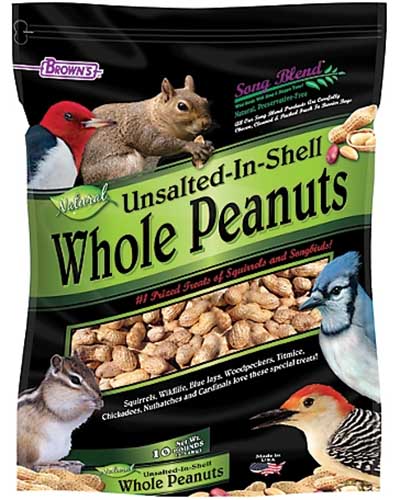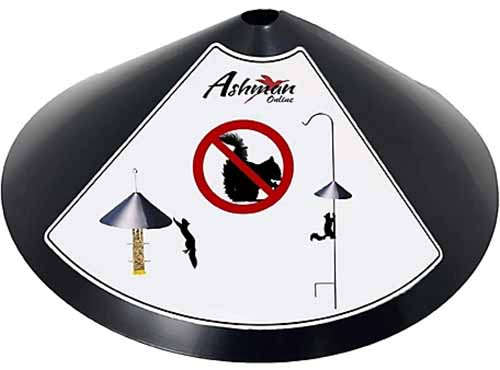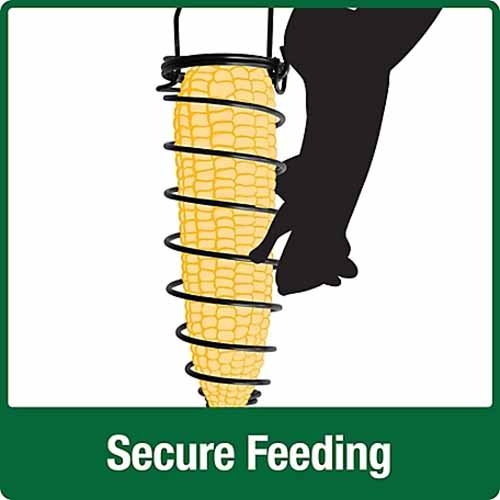Wild birds are a pleasure to watch in our yards during the winter months.
But it takes more than just food to create a welcoming stopover for birds during the cold months of the year – our feathered guests have other important needs as well!
For several years, my husband and I have dedicated time and resources to creating a hospitable environment for birds and other wildlife on our small farm, particularly during the winter months.
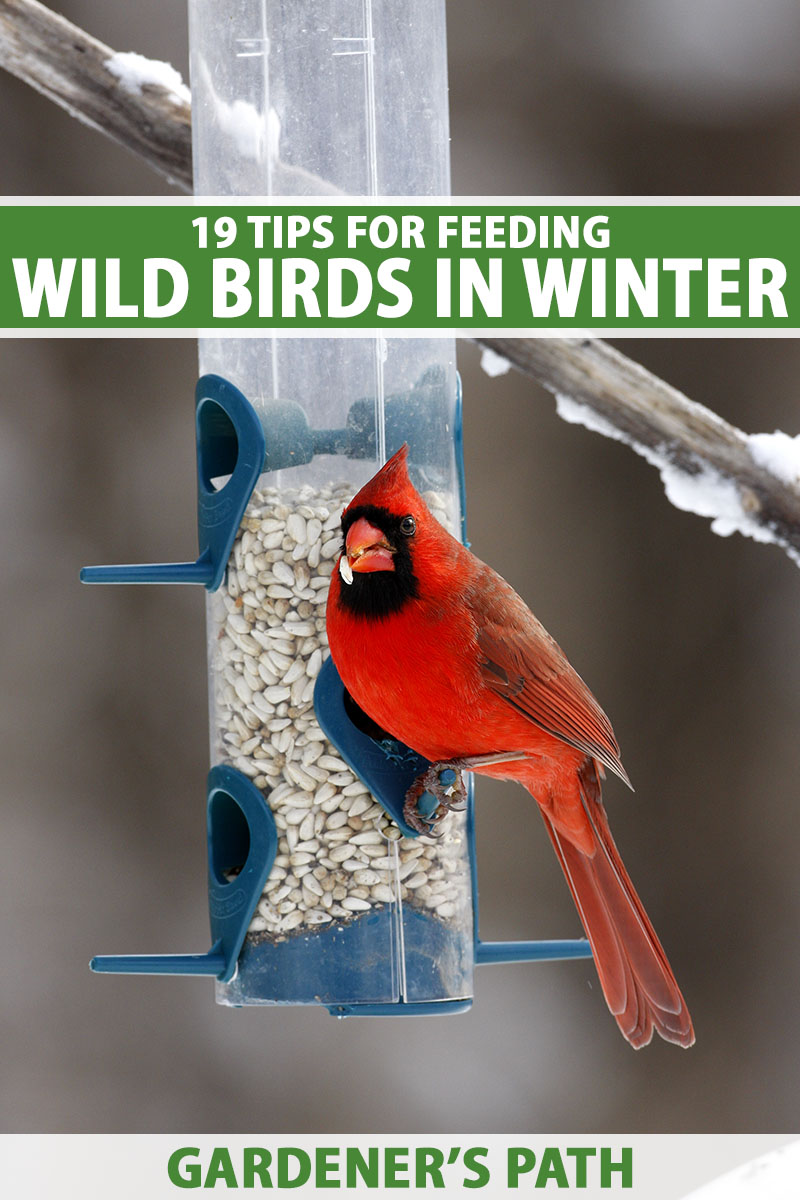
We link to vendors to help you find relevant products. If you buy from one of our links, we may earn a commission.
I wanted to be sure we’re keeping wild birds safe as they dine at our feeders – and I’m sure you do too.
In this article, I’m going to share 19 tips for feeding wild birds in winter, with advice gathered from wildlife biologists as well as insights I’ve garnered from my experience caring for our feathered visitors.
Not all fans of wild birds will need to implement all of these tips – though you might just be surprised at how many of them you’d like to try this winter!
Ready for a sneak peek?
Here’s what I’ll cover:
19 Tips for Feeding Wild Birds in Winter
1. Skip the Crackers and Bread
You may have grown up saving stale bread or crackers to feed to ducks or other birds in winter.
So if your plans for feeding wild birds include giving them your stale baked goods, it’s time for a reset – right now!

For wild birds, foods like crackers and bread do not make nourishing treats during the winter – or at any time. As far as our feathered friends go, these should be treated like junk food rather than healthy meals.
Instead, this winter, plan to purchase food formulated specifically for wild birds. We’re going to look at exactly what that means next.
2. Offer 3 Types of Foods
There are essentially three types of foods that are appropriate for feeding wild birds in winter – or at any time of the year – small seeds, large seeds, and suet or peanut butter.
Small seeds include canary seed, millet, and nyjer.
These small seeds will attract buntings (Passerina spp.), cardinals (Cardinalis spp.), doves (Columbidae), goldfinches (Spinus spp.), house finches (Haemorhous mexicanus), jays (Corvidae), juncos (Junco spp.), purple finches (Haemorhous purpureus), quail (Phasianoidea), pine siskins (Spinus pinus), sparrows (Passerellidae), titmice (Baeolophus spp.), and towhees (Melozone and Pipilo spp.).
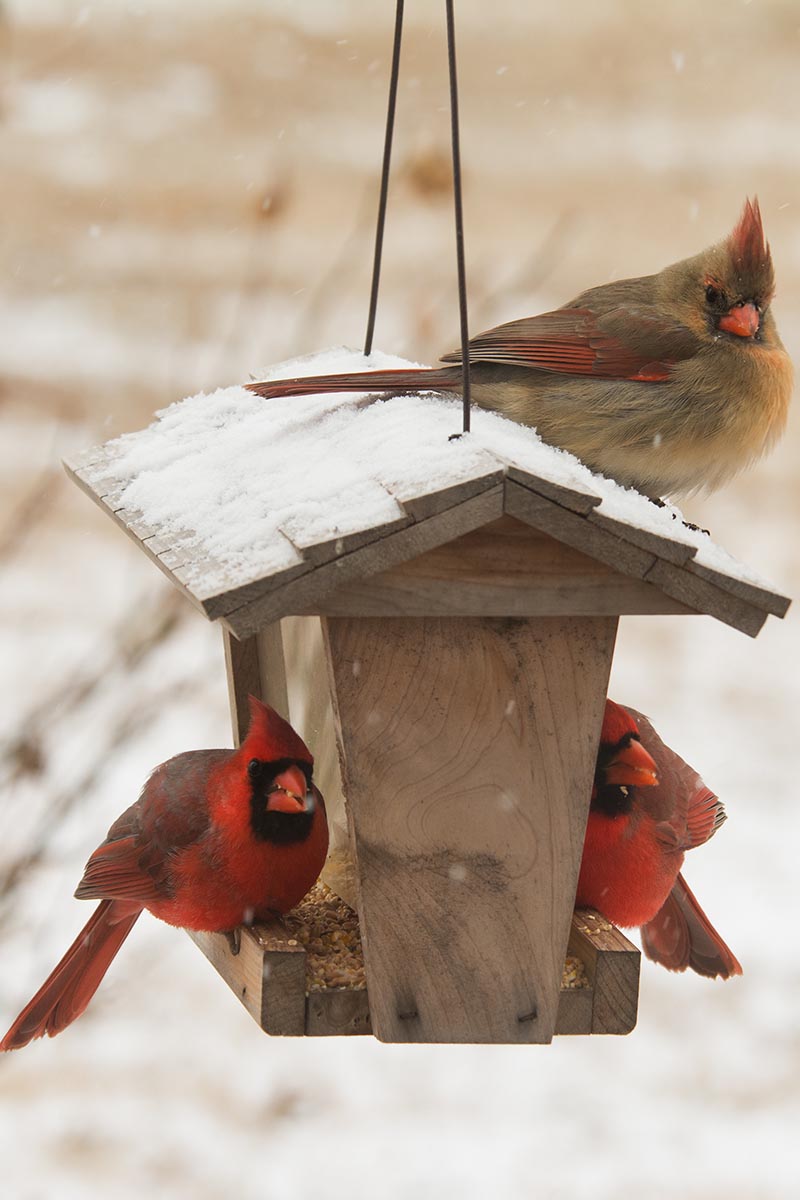
Large seeds include safflower, black oil sunflower, peanuts, shelled corn, and striped sunflower seeds.
With black oil sunflower seed being the real crowd pleaser, these larger seeds attract species such as cardinals, chickadees (Poecile spp.), goldfinches, grosbeaks (Fringillidae and Cardinalidae), house finches, jays, juncos, nuthatches (Sittidae), purple finches, sparrows, titmice, and woodpeckers (Picidae spp.).
You can offer either shelled or unshelled peanuts – just make sure you buy them unsalted and that there are no other ingredients.
10-Lb Bag Brown’s Unsalted In Shell, Whole Peanuts
You can find unsalted, in-shell, whole peanuts in a 10-pound bag from Brown’s via Tractor Supply.
Both suet and peanut butter can be helpful sources of fat for wild birds. Only put out suet during the coldest months of winter however, as it can spoil in warmer conditions.
Suet and peanut butter will attract species such as bluebirds (Siala spp.), chickadees, goldfinches, jays, mockingbirds (Mimus spp.), nuthatches, titmice, and woodpeckers.

Are you wondering about offering ingredients like milo, oats, and wheat this winter?
Most wild birds ignore milo, oats, and wheat, and the uneaten seeds can cause the rest of the mix to go bad.
Avoid seed mixes that include these ingredients unless you are specifically trying to attract doves, pheasants, or quail.
3. Provide Fresh Water
Another necessity for a thriving community of wildlife in winter is a source of clean, fresh water.

You may have birdbaths for your feathered friends to use during the warmer months – but in winter, water can freeze and remain frozen unless you take action to prevent it.
My approach is to put out shallow, stainless steel, rimmed bowls of water – the same type of water dishes that my pets drink from.
You can find two-quart stainless steel water dishes available via Amazon.

Stainless Steel Pet Feeding Dish
During my long, cold winters in USDA Hardiness Zone 5b, I fill these dishes with fresh water every morning.
The birds take advantage of the water during the day, and then the water freezes overnight. The next morning I dump out the ice that has formed and refill the dishes with fresh water.
That’s a low budget, DIY approach, however.
If you prefer something that won’t require attention as often and have an outdoor outlet handy, you can use a heated birdbath to provide your feathered visitors with drinking water in winter instead.
This heated birdbath can be used throughout the year – just unplug it during the warm months.
It’s made from powder coated steel and plastic, measures 14 inches across and two inches deep, and holds two quarts of water.
It prevents water from freezing when air temperatures are as low as -10°F. Plus, it can be either clamped onto a deck or set on the ground.
You’ll find this All Seasons Three-In-One Powder Coated, Heated Birdbath available for purchase from Gardener’s Supply.
Even in winter, be sure to clean birdbaths and water bowls every few days, or more frequently if the water is dirty.
Scrub with soapy water, use a mixture of one part three percent hydrogen peroxide to nine parts water to disinfect them, then rinse.
Looking for a larger selection of options? Learn about the best birdbaths in our guide.
4. Supply a Source of Grit
If you’ve ever kept backyard chickens, you know birds need grit to help them grind down their food, and that includes wild birds too.
Wondering why this is?
Our feathered friends don’t have teeth, so gizzards and grit do the job of grinding food in the place of dentition.
If you have sandy soil, your feathered visitors may be getting plenty of grit as they peck for seeds on the ground.

However, the soil may be covered with snow in winter.
A simple way to provide wild birds with grit is to sprinkle ground eggshells at the base of the feeder or mix some in with your seed mix.
To kill bacteria, make sure that the eggshells have been heated to at least 170°F first, before grinding them.
Read our article to learn more about drying eggshells, as well as composting, amending soil, and practicing pest control with this natural food waste!
5. Clean Up Under Feeders
You don’t return to your dinner table day after day without ever washing it off, do you?
Likewise, if you commit to providing food for your feathered friends in winter, you’ll need to also commit to keeping their dining area clean for hygiene reasons.
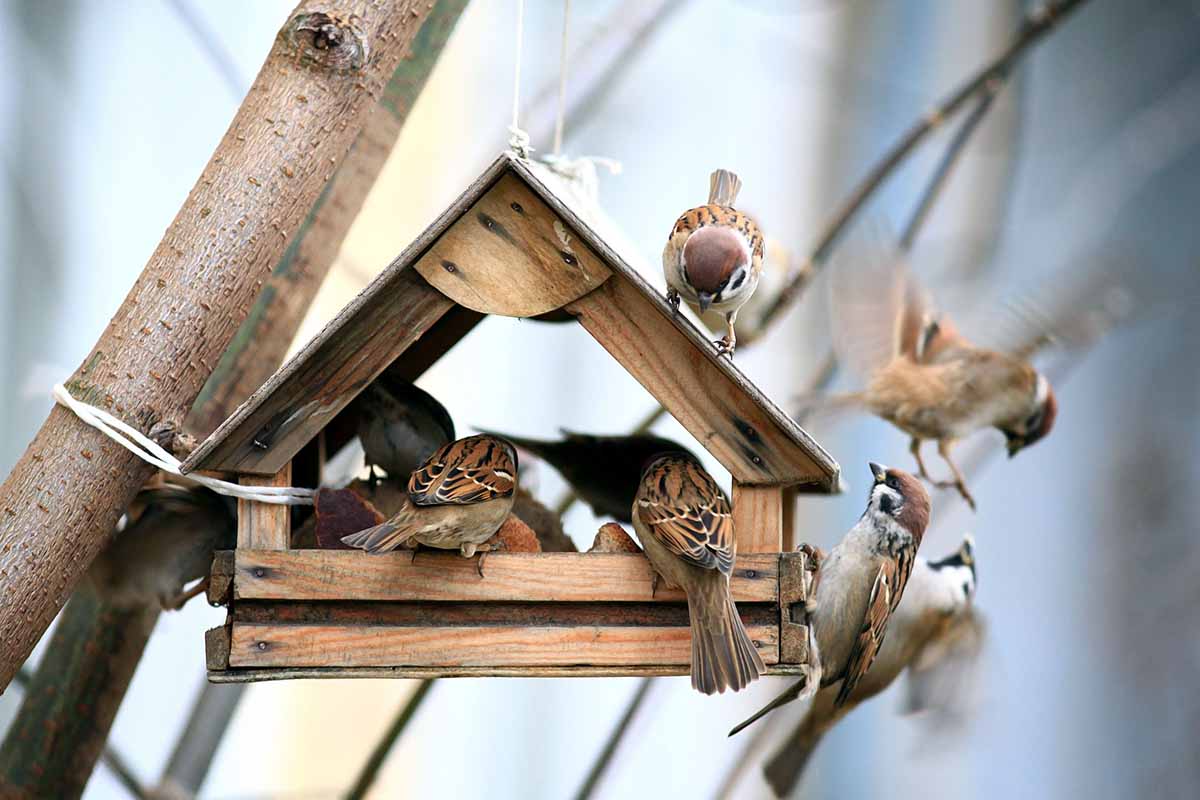
Just like with big crowds of humans, when large groups of birds congregate, it increases the risk of disease spread – even in winter time. Diseases such as avian flu spread through multiple routes, including feces, nasal secretions, and saliva.
So those discarded shells and droppings that pile up underneath the feeder? Periodically you’ll need to remove any piles of debris to keep conditions sanitary.
6. Relocate Food Stations Seasonally
In addition to periodically removing the piles of hulls that accumulate around wildlife dining areas, you should also plan to relocate food stations occasionally.
Once again, this is to keep conditions hygienic for our feathered friends.
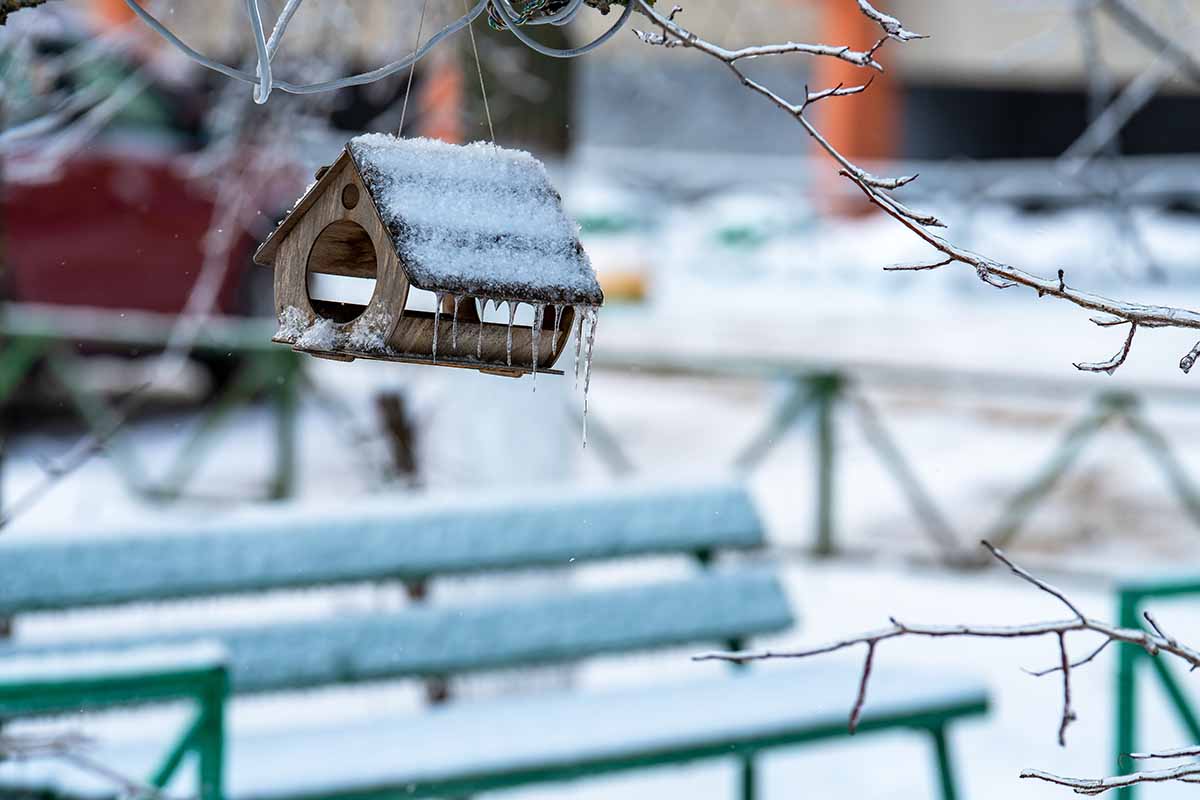
Relocating food stations at the start of a new season is a good plan. At the beginning of winter, move the station to a new location.
Do this again at the beginning of spring, and once again at the start of summer and fall, rotating stations between different spots.
This rotation routine is another step designed to help prevent the outbreak of sickness among your flocks of wild visitors.
7. Clean and Disinfect Feeders
While tidying up below the food station will help in the hygiene department, the feeders themselves also need to be cleaned periodically.
Plan to clean and disinfect your feeders at the beginning of winter season, and again at the end of each season if you plan to continue offering food throughout the year.
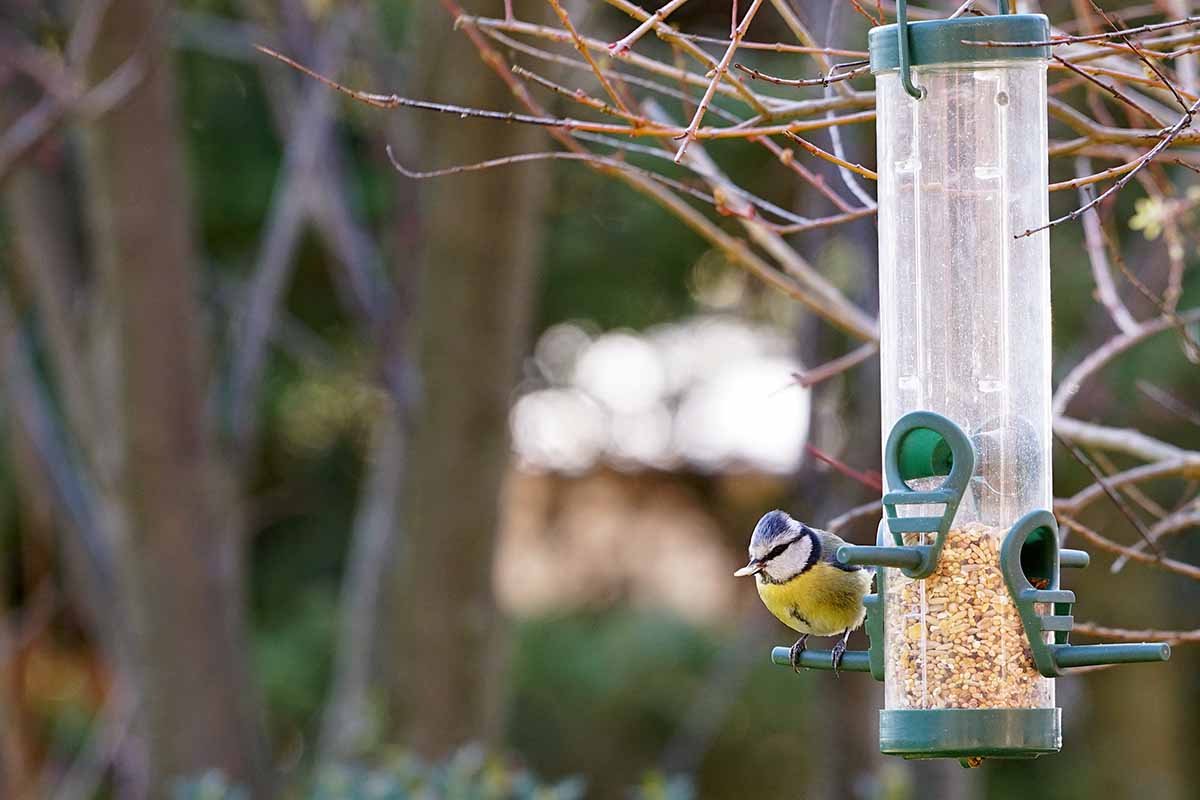
If bird seed becomes damp and clumped up, it will quickly start to develop mold, so you may need to clean and disinfect more often if this occurs.
Also, if you have noticed any sick looking birds in your yard, remove the feeders for a couple of weeks. You may also want to reposition them in fresh locations after cleaning.
To clean feeders, scrub them with soap and water. They can then be disinfected with a mixture of one part three percent hydrogen peroxide to nine parts water.
Rinse them well and allow them to dry before refilling.
8. Offer Different Feeder Types
If you’d like to attract a diverse assortment of avian wildlife to your yard this winter, try setting out a selection of different types of bird feeders.
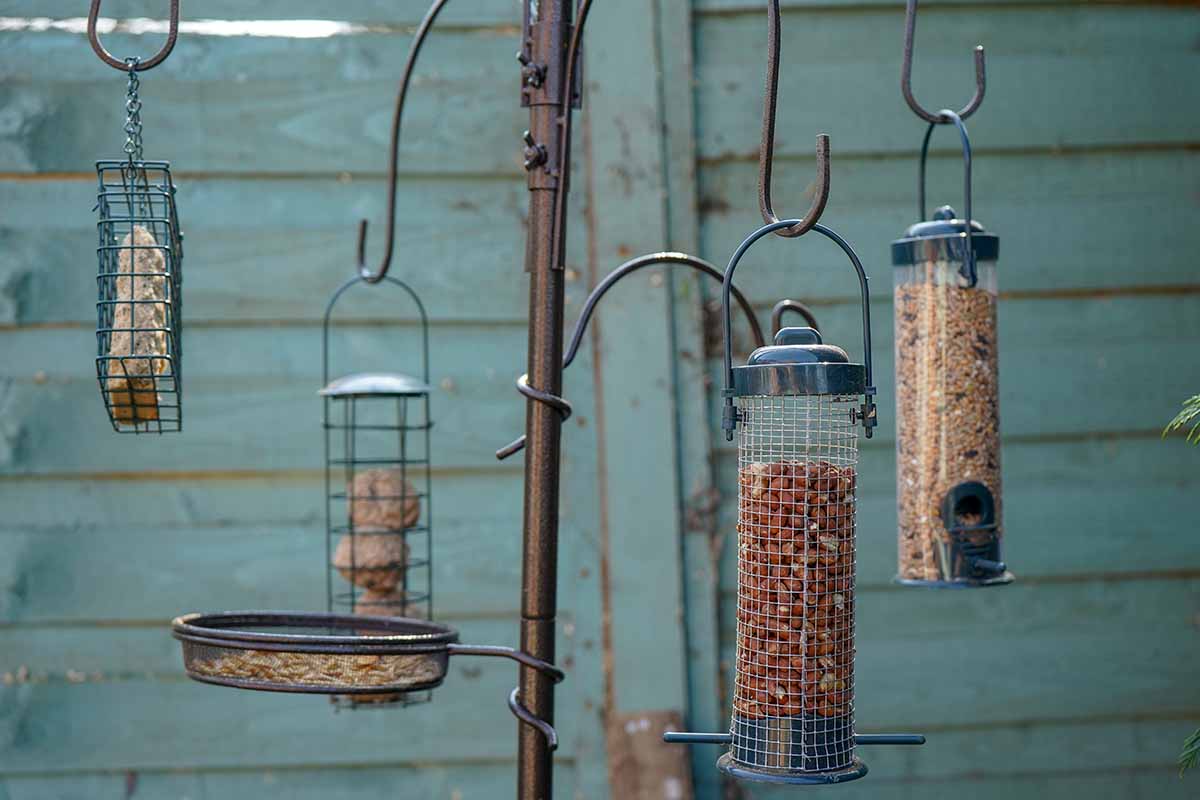
The different types include tubular models, trays, window units, and hoppers.
When you are using multiple feeders, spread them out in various locations to prevent large numbers of birds gathering in the same spot.
This is another tactic to help reduce the risk of disease spread during the winter and throughout the year.
Learn more about different types of bird feeders in our guide.
9. Hang Feeders at the Right Height
Have you ever wondered if there’s a best height for hanging bird feeders?
The answer is yes – and that’s about five to six feet high.

This height will keep birds out of the reach of cats as well as keeping the feeder easily accessible for you to refill.
Heights above six feet aren’t a problem for our feathered friends, but you don’t want to have to use a ladder to refill your food station when winter weather has made the ground slick with snow and ice, do you?
10. Locate Food Stations Out of Wind
If possible, arrange your food stations so that they have some protection from cold winter winds.
This means you’ll first need to identify which direction winter winds tend to come from in your location.
If you’re not aware of prevailing wind patterns, it’s quite possible that strong winter winds are a rare occurrence in your area, and you can probably skip this step.
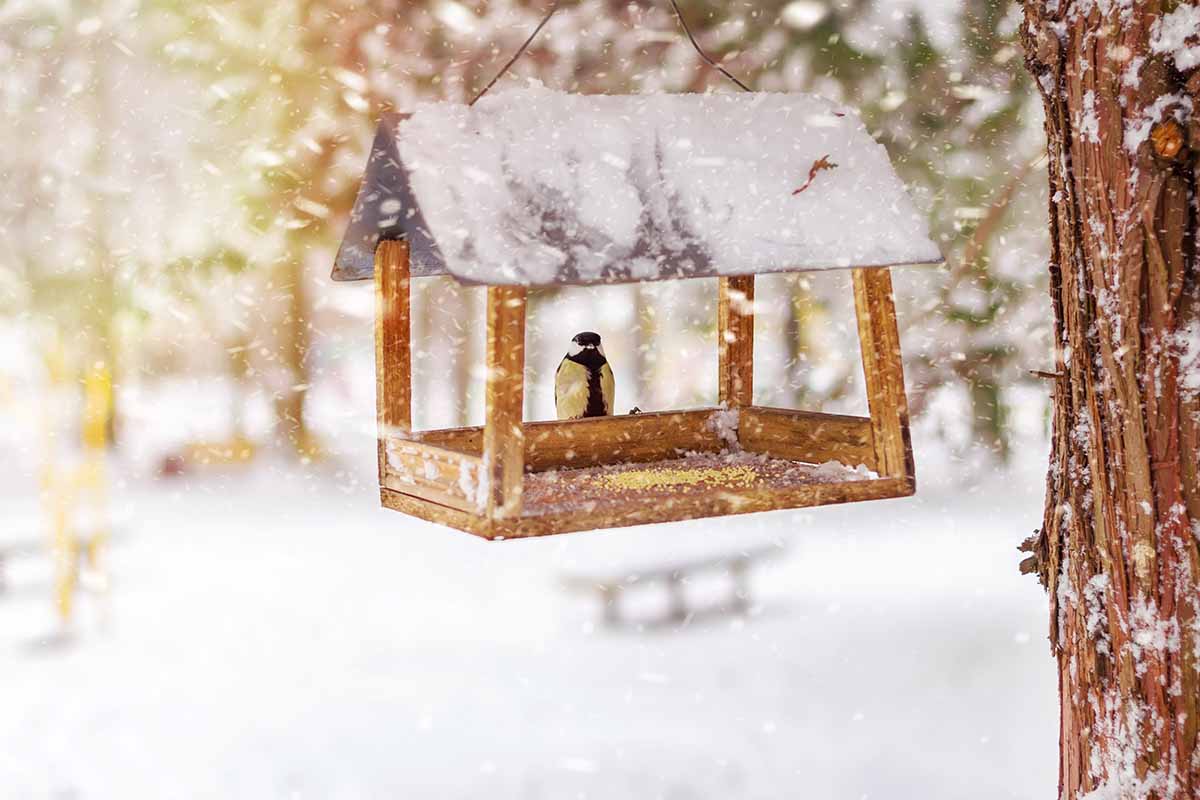
Different structures can provide wind blocks, including buildings, hedgerows, and trees.
Conifers in particular will provide good protection in winter since they don’t drop their leaves, so keep this in mind when positioning feeders.
11. Prevent Window Collisions
Wanting to invite our feathered friends for a feast is a heartfelt sentiment.
Yet, it can be dangerous to these animals because of the hazards they might encounter in our yards during the winter and throughout the year – and that includes windows.
According to the US Fish and Wildlife Service, window collisions kill an average of 600 million birds per year in the US, making windows the second biggest human-caused threat to birds.
Wondering what threat number one is? We’ll get to that later in the article, so keep reading.
Windows reflect both sky and vegetation – and sadly, birds can’t tell the difference between reflected sky and trees and actual sky and trees, making large panes of glass especially dangerous to them.
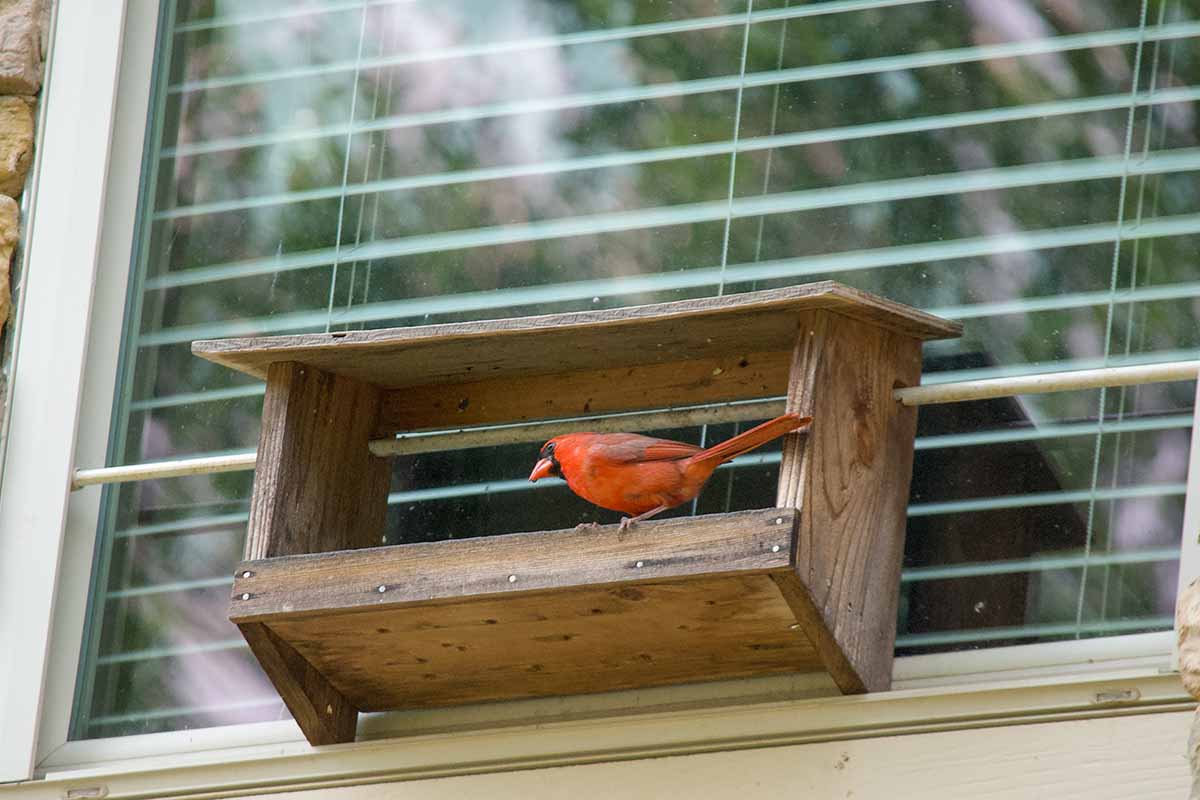
While big, shiny skyscrapers in cities are the biggest problem, even window panes on houses are responsible for their fair share of bird kills. And large picture windows are particularly problematic.
Thankfully, there are ways for ornithophiles to make the windows of their homes safer for birds – the first is to position food stations wisely.
Most ornithological experts recommend locating feeders within three feet of a window.
At less than three feet, the bird won’t build up enough momentum and will be less likely to hurt itself if it flies into the window.
If placing food stations within three feet of a window isn’t possible, it’s best to place them more than 30 feet away from panes of glass – at this distance, wild birds will be less likely to hit windows as they approach and depart from food stations.
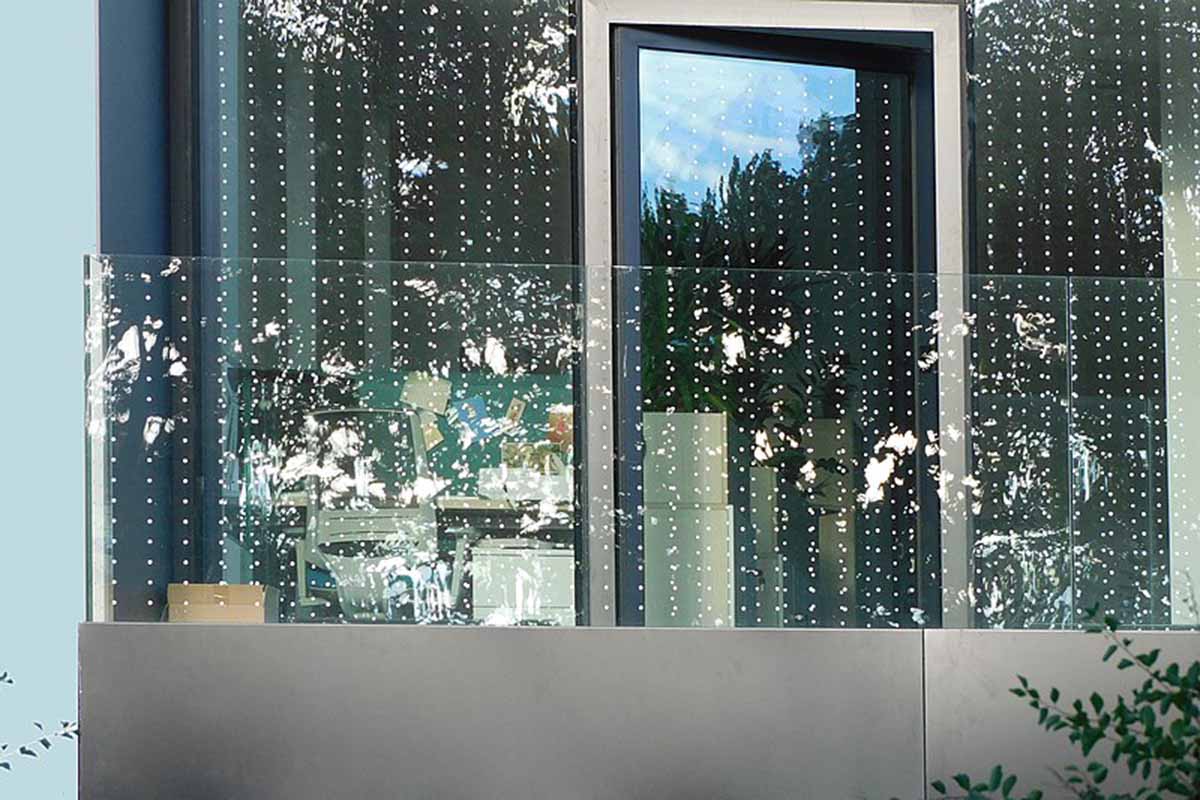
In addition to following these feeder placement recommendations, adding collision deterrents to windows saves lives.
Examples of proven deterrents include ribbons or strings that hang vertically, exterior shades or screens, privacy window film, and window markers, tape, or decals.
You can even make designs on windows with a dry bar of soap or with washable tempera paint.

You can find washable tempera paint sticks available from the Zenacolor Store via Amazon.
Both of these options will need to be reapplied after rain washes away your artwork!
Higher end deterrents include etched window panes and decorative window grills.
Want to make your greenhouse bird-safe too? Consider whitewashing its panes.
But before you get started making your windows bird-safe, there are a few things you should know.
According to the Fatal Light Awareness Program (FLAP) Canada, collision deterrents should:
- Be placed on the exteriors of windows
- Be densely patterned with gaps no bigger than two inches
- Be highly contrasting
- Feature patterns that cover the entire surface of the window pane
- Feature patterns that are at least a quarter of an inch wide
And do note – if you’re choosing window decals, according to FLAP there’s not enough evidence yet to prove that transparent, UV-light-reflecting decals are effective, so steer clear of those for now.
Not surprisingly, reviews for those types of collision deterrents are very mixed.
After considering many different options, I find collision tape that creates a grid of small square or circular dots to be the most aesthetically pleasing – and least noticeable.
You can purchase 30 meter rolls of this Bird Strike Prevention Marker Tape via Amazon.
Be sure to follow the manufacturer’s recommendations when applying it.
12. Grow Native Shrubs, Trees, and Perennials
Once your windows have gotten the safety treatment, you might want to move on to a more garden-focused project – creating a wildlife-friendly, native landscape.
And if winter has already set in, it may be too late to plant, but it’s never too late to plan – especially with the help of a trusty garden journal!
When you grow native trees, shrubs, and perennials, you’ll provide your feathered friends with sources of homegrown food for winter, as well as habitat for nesting and seeking cover.
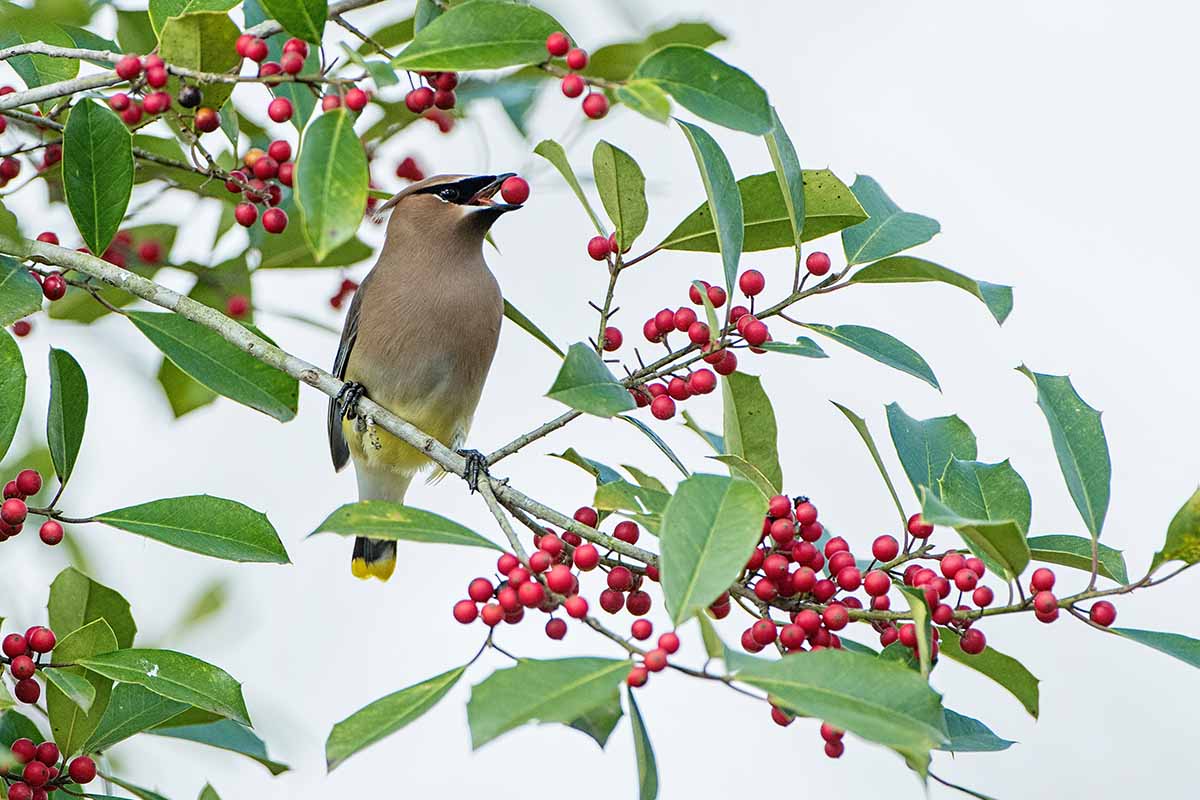
Native wildflowers such as coneflowers are an excellent source of winter seed for wild birds.
And native shrubs and trees can offer wildlife an important source of nutrients during the cold winter months, as well as attracting larval insects which can serve as food for bird babies in spring.
Want to discover some of the best winter berry producing trees and shrubs for wildlife? Read our guide!
13. Provide a Brush Pile
If your landscaping is not yet established and doesn’t currently provide much shelter for wild birds, a brush pile is an excellent feature to include for the winter and throughout the year.
And even if you do have established trees and shrubs, a brush pile may be a feature you’d like to consider incorporating into the back corner of your yard as a wildlife-friendly resource that will attract a variety of small animals.
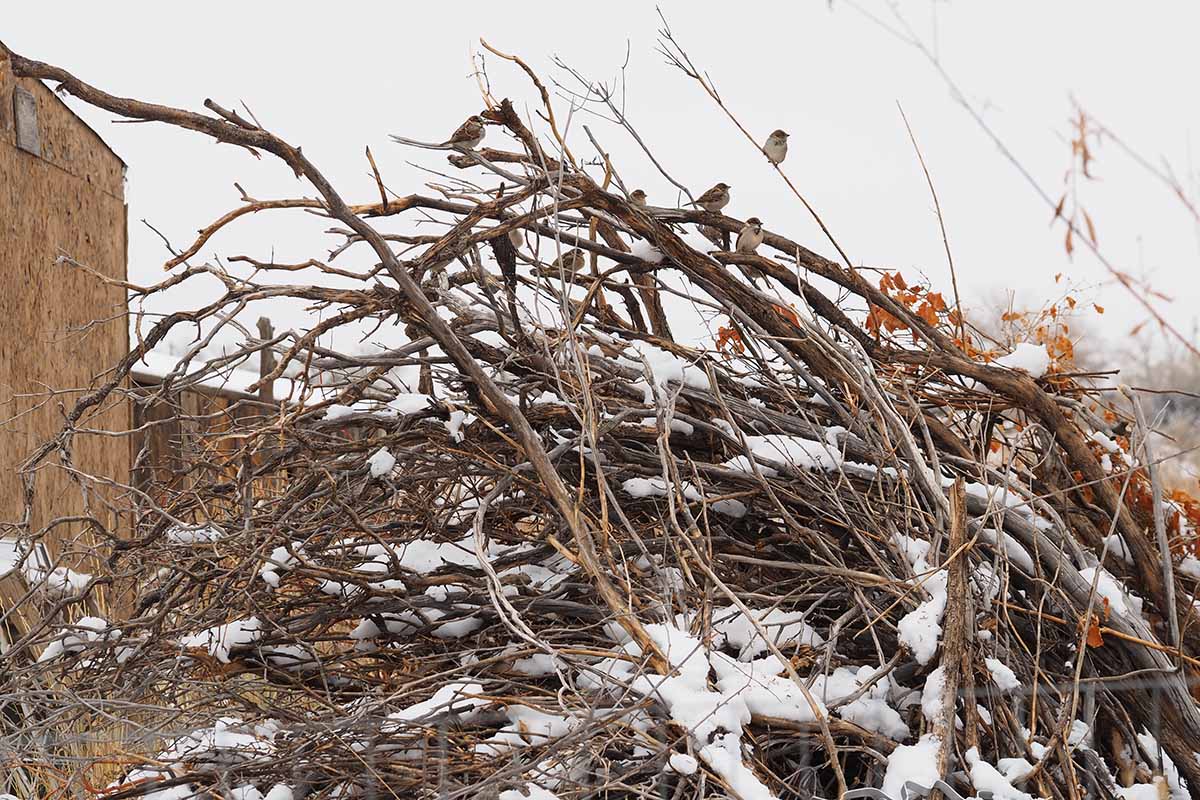
You can use trimmings from woody plant prunings to create and add to the brush pile. It will shrink as twigs and branches decompose.
Make brush piles between three and eight feet tall and six to 20 feet wide.
Keep piles loose, rather than compact. This gives wild birds opportunities for perching safely in the interior of the pile.
14. Offer Mealworms
Once you have established native trees and shrubs thriving in your yard, adult birds will be much more likely to find plenty of larval insects to nourish their babies.
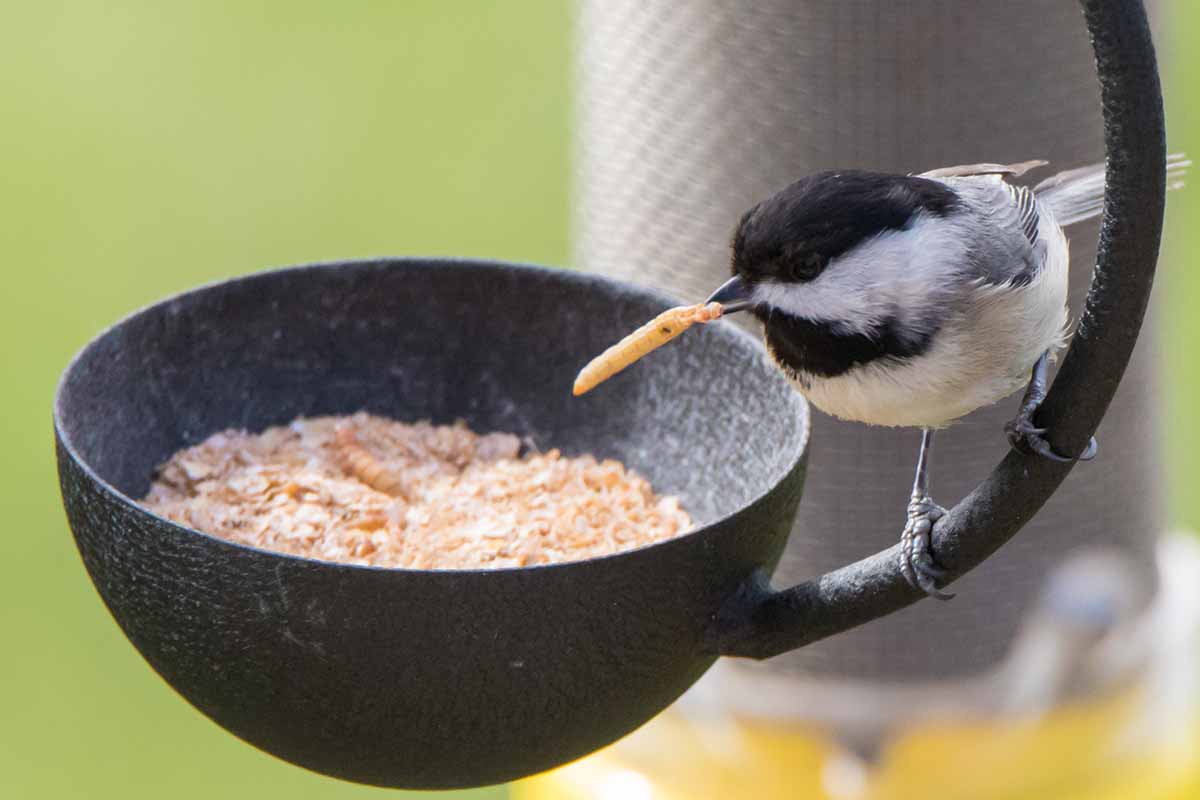
Until then, though, you might want to supplement with mealworms.
In addition to being good “baby food,” mealworms provide an excellent source of protein that can help our feathered friends when winter weather is bitterly cold.
You can pick up a 30-ounce bag of mealworms from Flock Party via Tractor Supply.
Wondering how to offer mealworms as wildlife treats?
You can mix them into the regular food, or place them in designated feeders, such as hanging mesh trays that will prevent rainwater from pooling.

This seven-inch metal mesh feeding tray works great for offering mealworm treats, and is available from Wildlife Friend via Amazon.
15. Fence Around Food Stations
There are a few different reasons you might want to place a ring of welded wire fencing around food stations.
One reason is to prevent your dogs from eating fallen seeds. Another is to help protect birds from outdoor cats – either your own feline companions or strays.
In addition, deer may also be attracted by bird seed on the ground, especially in winter when other resources are scarce.
Preventing them from accessing this source of food can help forestall the spread of Chronic Wasting Disease, a malady that is befalling deer in many areas of the US.
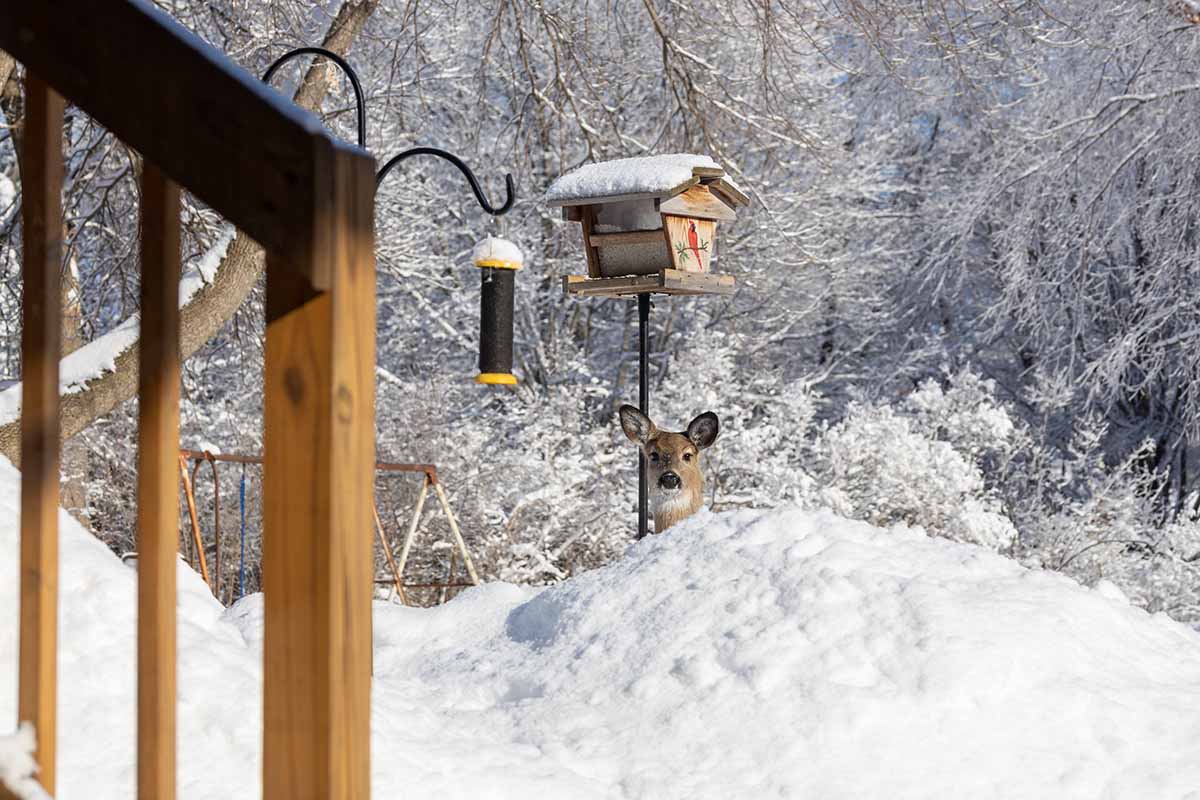
Fencing around food stations can be lightweight and moveable, so that when you reposition your feeder at the end of the season, you can easily relocate the fencing as well.
Making a cylindrical, DIY fence around a food station from welded wire fencing is quite easy.
Simply use some wire cutters to cut some three-foot-tall welded wire fencing to a length of 13 feet, leaving the wire ends protruding on the cut end.
Stand the fencing upright, overlap and join the two ends together around the feeder, and use the protruding wires to fasten the cylinder together. Voila! This makes a circular fence that is four feet wide.
25-Foot Roll of Red Brand 3’ Welded Wire Fencing
You can purchase a 25-foot roll of three-foot tall welded wire fencing from Red Brand via Tractor Supply.
16. Protect From Cats
Remember earlier in the article when I said we’d get to the number one human-caused threat to birds? That’s right, it’s Felis catus – the domestic cat.
On average, cats kill nearly two and a half billion birds per year. In the world, you might ask? Nope, that’s just in the US.
In addition to placing fencing around food stations, there are other solutions for keeping wild birds safe from our delightful but deadly fur babies during the winter and throughout the year.
Of course the ideal solution would be to make outdoor felines into indoor cats – allowing them to watch activity at food stations while safely confined indoors.

But not all cats are amenable to purely indoor life, however, and I have one such feline among my collection of pets.
Thankfully, I found a solution to greatly reduce this cat’s avian predation – a colorful collar cover that alerts birds to his presence.
If you’ve tried placing a bell on your cat’s collar and been frustrated by the lack of results from this warning method, rest assured, colorful collar covers are far more effective.
Cats wearing these collar covers kill an average of 75 percent fewer birds, compared to those without collar covers.
Birds Be Safe Cat Collars are 100 percent cotton and come in bright, contrasting colors that our feathered friends see as warning signs.
A breakaway collar is threaded through the colorful collar cover, allowing the collar to pop off if your kitty gets stuck on anything.
Will it make kitty look just a little clownish? Yes! But it’s also incredibly cute.

Geodelic Birds Be Safe Cat Collar
Purchase a Birds Be Safe Cat Collar Cover in a Geodelic pattern from the Birdsbesafe Store via Amazon.
And don’t forget – you’ll need a breakaway collar as well.

2-Pack Breakaway Cat Collar in Orange
You’ll find a two-pack of breakaway cat collars in your choice of sizes and colors from the Taglory Store via Amazon.
These colorful collars reduce predation dramatically, but you’ll still need to make sure there are no locations where cats can hide and ambush your feathered guests.
Once again, smart placement of food stations can help – place them 10 feet away from trees or anywhere else cats could jump out and ambush birds.
17. Discourage Squirrels
Deer aren’t the only uninvited guests who might show up at your food stations – resident squirrels often decide to enjoy themselves at the winter buffet too.
This wouldn’t be so much of a problem if they didn’t end up hogging all the food, often preventing birds from getting their fair share.
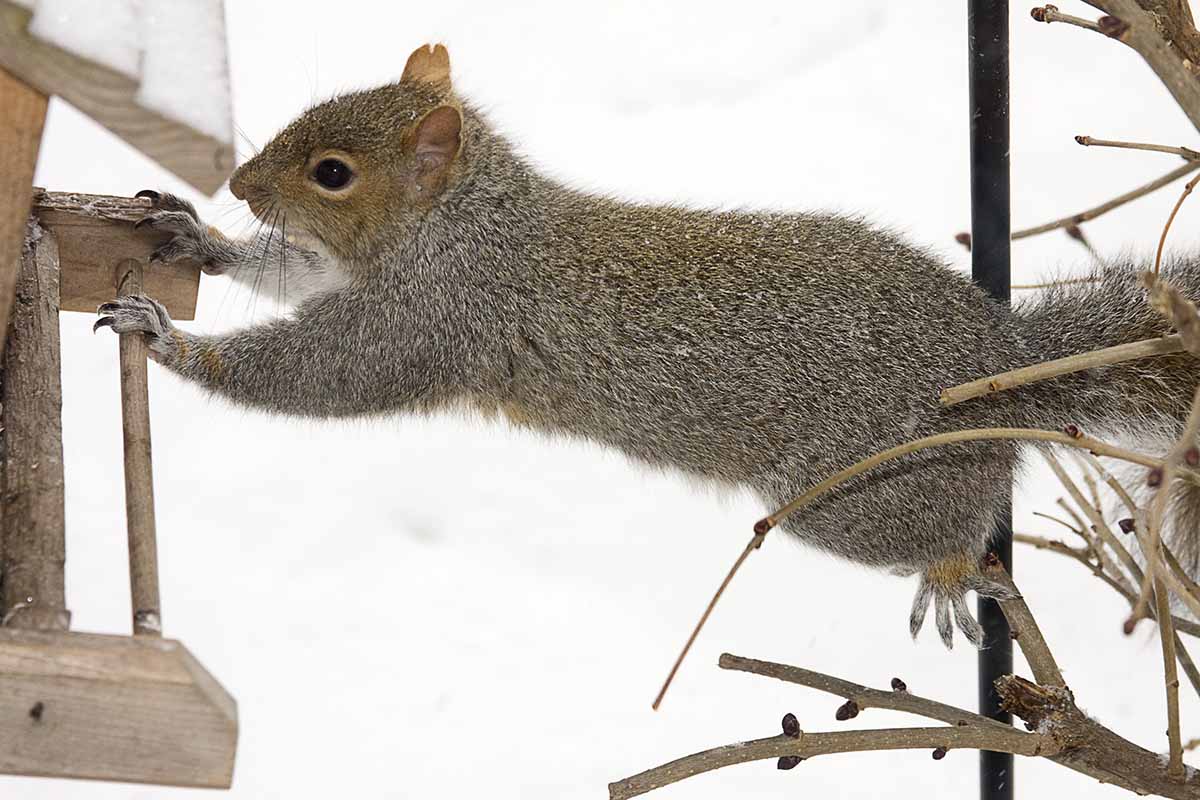
If this has been an issue for you, you probably know that keeping squirrels away from food stations can be an ongoing battle.
There are a few ways you can dissuade squirrels from dining at your bird feeders in winter, and you may need to try all of them for these efforts to be effective.
Place poles for food stations in open areas, at least ten feet from trees or shrubs, and use cone shaped baffles that are at least 17 inches wide.
This 17-inch wide, powder-coated, galvanized steel baffle is made in the USA and is available for purchase from Ashman via Tractor Supply.
Another strategy to keep squirrels from eating all your winter bird seed is to offer squirrels their own food stations away from those dedicated to birds.
Sunflowers in hulls, peanuts in shells, and ear corn all make good treats for squirrels and are slower to eat, keeping squirrels busy for longer periods of time than hulled sunflower, shelled peanuts, or cracked corn.
You’ll find 15-pound bags of ear corn for purchase from Royal Wing via Tractor Supply.
How do you offer ear corn to squirrels? On a corn cob feeder of course!
Just hang it from a sturdy tree branch, well away from bird food stations.
Wild Wings Critter Corn Cob Feeder
This black metal Wild Wings Critter Corn Cob Feeder holds one corn cob at a time, and is available for purchase via Tractor Supply.
18. Be Bear Aware
While many of us who enjoy feeding wild birds in winter are also dedicated to caring for other types of wildlife, the use of bird feeders is not recommended when bears are about.
Providing food for bears, either intentionally or unintentionally, puts both bears and humans at risk.
So in areas where bears frequently visit food stations or topple garbage cans, we must forego the use of feeders, both for our own safety – and that of the bears.
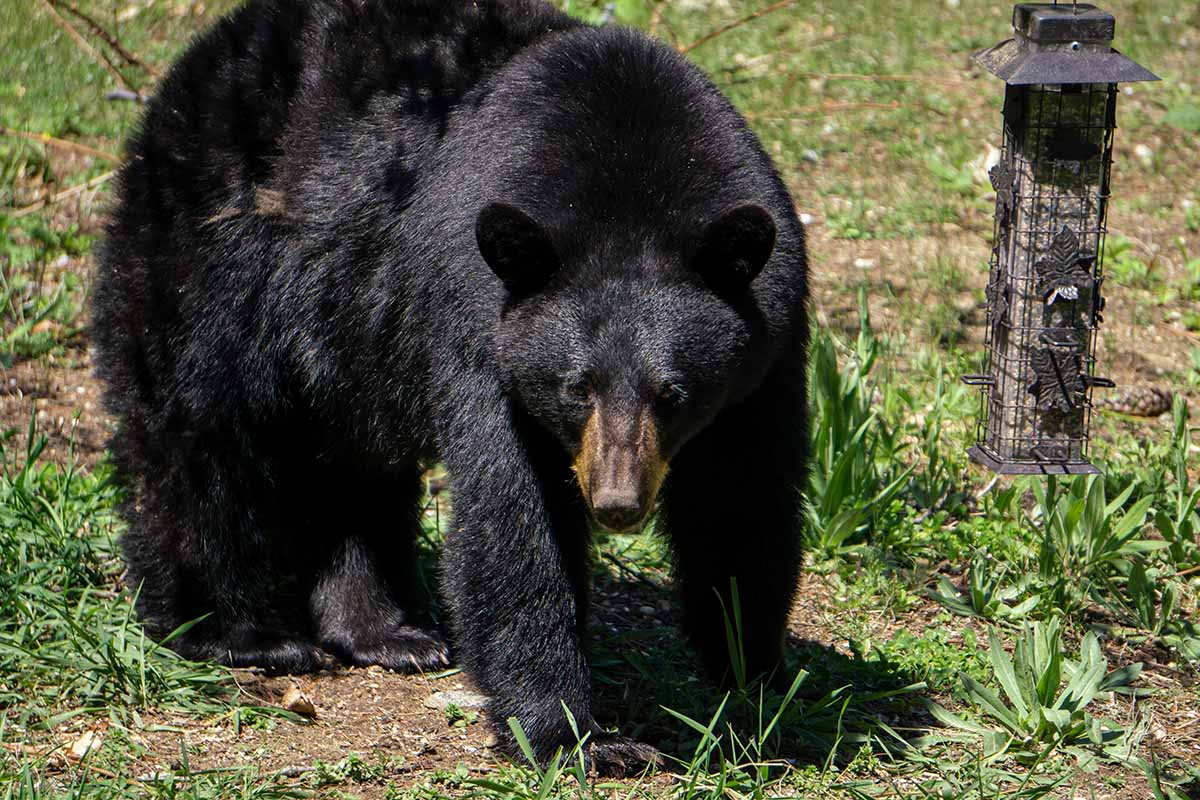
In many locations bears may be hibernating during the winter months, and homeowners in these locales may be able to safely feed birds by waiting until bear activity stops before putting out food stations.
But for those who live in locations where bears remain active during the winter, it’s best to forego the feeders altogether.
Any food placed outdoors is likely to attract bears, putting both yourself and these large omnivores at risk of a human-wildlife interaction gone wrong.
19. Identify Wild Birds
Finally, once your winter food stations are safely positioned, you have cleanup on your chore schedule, and you know exactly what you want to feed your feathered friends, don’t forget to keep a bird book by your side!

Keeping track of which types of birds show up in your yard over the winter can help inform you as to any adjustments you’ll need to make to your wildlife feeding operation – in addition to the excitement and pleasure of knowing exactly who is showing up at your feeders!
Looking for a guide to wild birds? Read our review of the National Audubon Society’s Birds of North America.
Impeckable Winter Feeding
With this list of 19 tips for feeding wild birds during the winter, you’re now prepared to keep these guests healthy and safe when they visit your feeders.
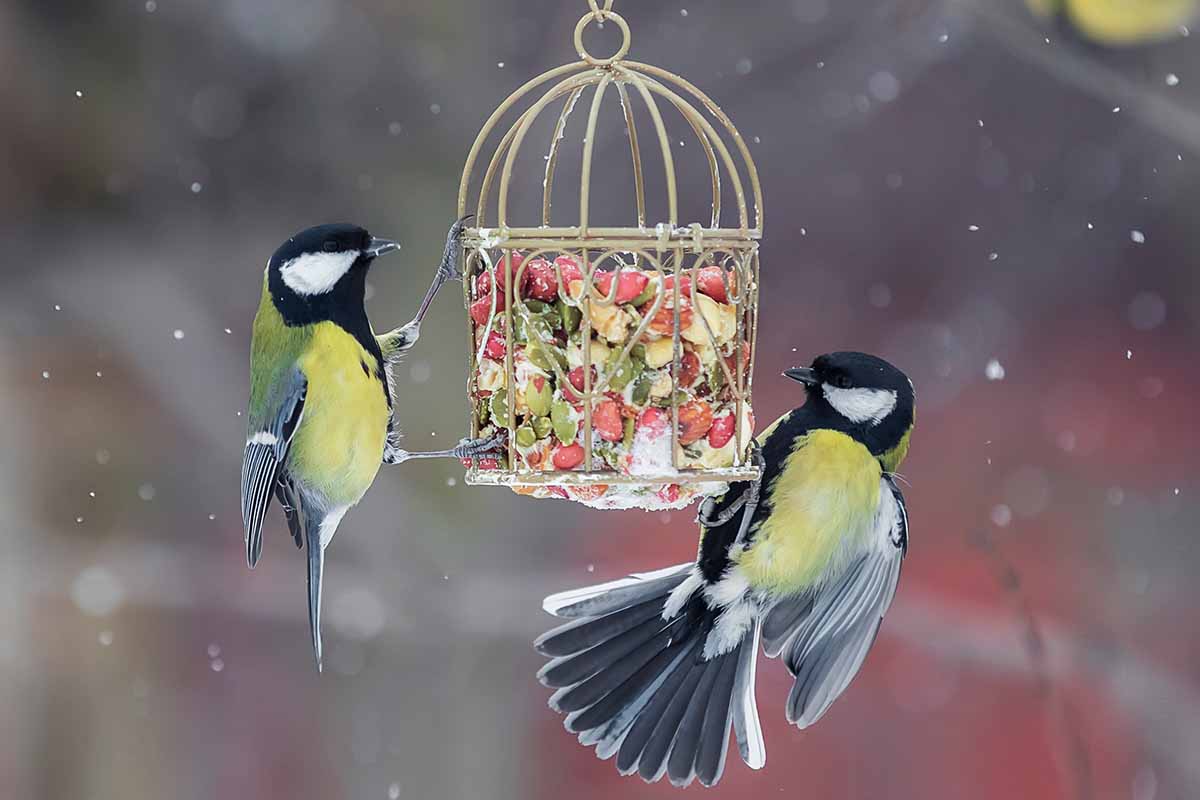
Be honest – did you learn that you had room for improvement when feeding wild birds during the winter? Are you having any other issues offering treats to wildlife in your yard? Let us know in the comments section below!
And now that your winter wild bird feeding skills are up to snuff, perhaps you’d like more tips about enjoying wildlife in the garden? Check out these guides next:
